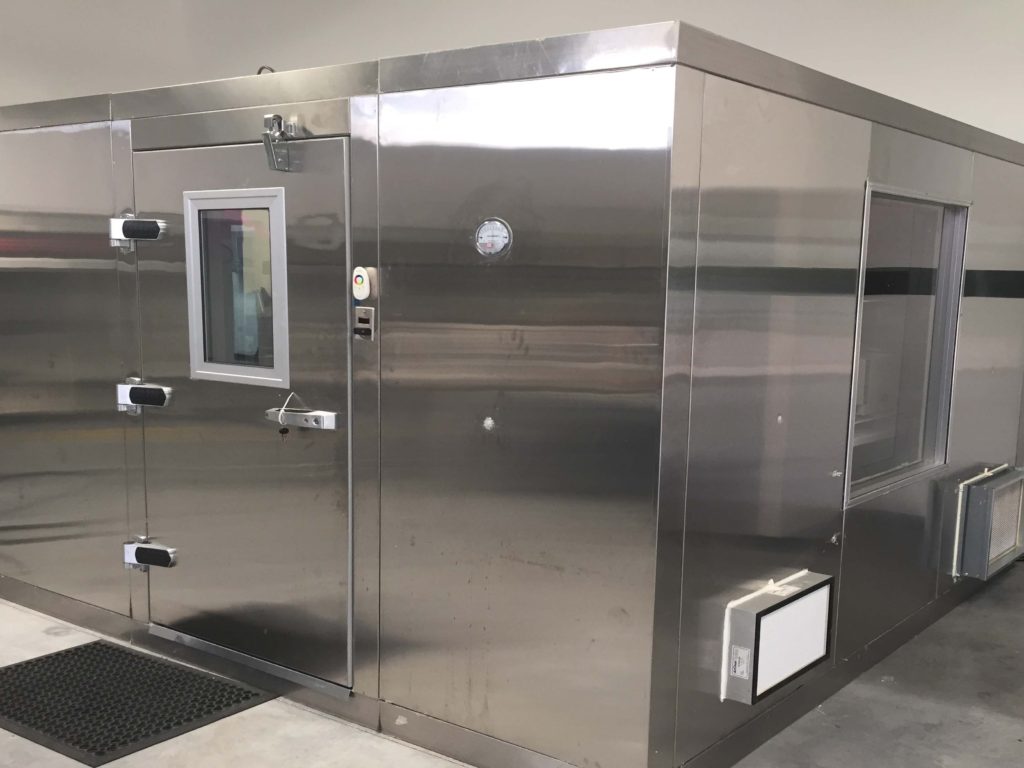Efficacy against aerosolized MS2 Virus & generalized pollutants (PM 2.5)
Recently an in-vitro study1. was performed to characterize the Halo’s efficacy at removing aerosolized MS2 bacteriophage and replicating an RNA single strained virus. MS2 is a surrogate virus and has been traditionally used for influenza and now SARS-CoV-2. Additionally, further testing was performed using various sizes of polystyrene latex microspheres (PSL) to represent a variety of particle sizes. As the Halo is equipped with an H14 HEPA filter, the filtration has the capability of capturing particles which are both pathogenic and non-pathogenic as small as 0.01 microns in diameter and with at least an efficiency of 99.995%. Due to the strategic ceiling placement and the Halo’s performance at reducing aerosolized pathogens, an average log reduction of 4.13 was proven. This equates to over a 99.99% reduction in total colony forming units (CFU’s). Additional independent particulate testing was also performed supporting the fact that the Halo, a ceiling-mounted air purification station, will not only capture particles as small as 0.01 microns in diameter1, but also dramatically reduce the total dose concentration occupants are exposed to. Additionally, being centrally installed in the ceiling is an ideal location to readily remove fine particles, pathogenic and general particulate matter (PM) 2.5 from our collective breathing zones and improve Ventilation Effectiveness within a room.
Log Reduction
In order to obtain results of total log reductions, testing must be performed within a large sealed test chamber to replicate a potentially contaminated room environment and to contain any potential release of aerosols into the surrounding environment. The test chamber used was constructed of 304 stainless with an internal dimension of 9.1ft x9. 1ft x 7ft, or 579 cubic feet.


To achieve consistent results, testing was performed in triplicate series with the Halo operational. A control run without the Halo on was also performed to generate a baseline and have comparative data. Each test performed ran for a 90-minute period.
General Timeline for Bioaerosol Chamber Testing

As aerosols are inconsistent in size, data was logged to plot the size distribution for MS2 and can be seen in the below graph (y axis represents total particles per cm at 106.)

The goal of this testing was to challenge the Halo P with MS2, a surrogate virus in a worst-case scenario situation and then monitor the log reduction in a consistent manner over a period of time. As seen in the below graph, the Halo P is proven to perform with extreme efficiency showing a steady reduction immediately upon the distribution of MS2 bioaerosols. Within 15 minutes, the Halo was able to achieve a 1 log reduction, which equates to over a 90% reduction in viable MS2. Within 45 minutes, the Halo P achieves a 2.5 log reduction equating to a 99% reduction, which is then followed by a continuous reduction with the final sampling at 90 minutes resulting in a net 4.19 log reduction, or 99.99% reduction in viable MS2.


Conclusion of MS2 viable test
While the overall viral dose that is needed to cause infection for SARS-CoV-2 has not been established, it is clear that exposure to viral dose concentration over time is the equation to a successful transmission rate. Because of this equation mitigating the risk of aerosolized transmission starts with proper ventilation, which encompasses many variables, including proper Air Exchange Rates (ACH), ventilation effectiveness (VEFF), or otherwise known as proper room mixing, and filtration. However, having all these criteria met is extremely challenging. In fact, most facilities, ventilation systems (HVAC) are not equipped to handle such changes required as per ASHRAE’s guidance for reopening buildings and schools. The Halo P provides a condition that will meet all criteria, increasing ACH, improving VEFF, adding medical-grade HEPA filtration and providing room level mitigation. The Halo P offers a permanent infrastructure improvement without the need of actually improving the building infrastructure. The efficiency of reducing aerosolized pathogens is also coupled with the overall improvement of indoor air quality (IAQ), which is achieved by not only reducing the risk of airborne transmission, but also reducing bacteria, mold, fungal spores and general PM 2.5.
1. All references, photos, diagrams and charts are derived from the detailed report from Aerosol Research and Engineering titled “Efficacy of the Erlab Halo P Device against Aerosolized MS2 Virus” by Sean McLeod and Jeffrey Trolinger.
ASHRAE guidance for reopening buildings:
ASHRAE guidance for reopening schools:



